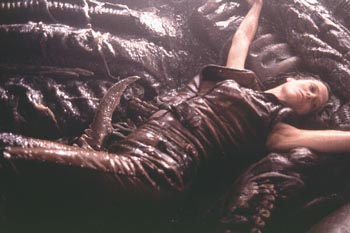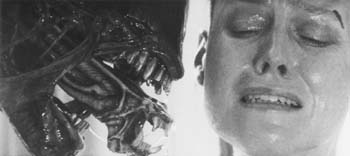Alien Notions
Four films and an ocean of goo later, the Alien series turns the monsters into embracable 'big chaps' and drains the life out of the humans
'BIG CHAP" they nicknamed him. In his book Retakes, John Eastman notes that the Big Chap suit was manned by one Bolaji Badejo, a 7-foot-2 Masai from Africa who was an exchange student in London, where the original Alien was filmed in 1978. Big Chap's appearance has changed over the years, as befits a protean creature, although its creator, H.R. Giger, goes uncredited in Alien Resurrection, the fourth film in the series. Big Chap and his descendants are always mutating, and you're never quite certain what you've seen: is it a tyrannosaurus or a squid, a crustacean or a lizard?
The space creature's reproductive cycle was described by Tom Figenshu in a 1980 article in Film Comment: "1. torpedo goo-pod, 2. tentacular spider crab, 3. angry whale baby, 4. pendulous porpoise and 5. malevolent sea monkey." The big mean brine shrimp aspect of the creature occasioned critic Frank Rich's sniping comment that it was "everyone's worst fantasy about shellfish."
Some of the other sea creatures in Big Chap's family tree include certain Devonian fish with armored skin and beady eyes--there's a dandy model of one (Dunckleosteous) hanging across the ceiling at Falls of the Ohio State Park in Indiana. He's big-mouthed and armor-skinned and has budlike primitive eyes.
From the way Dunckleosteous' face has been recreated, it doesn't even possess the shark's redeeming sense of purpose. The beasts that won't leave Sigourney Weaver's Lt. Ripley alone are also cousin to the moray eel, with its bullet head and poisonous blood, and of course to the octopus--a thousand, thousand slimy things, as a Coleridge line has it in Rime of the Ancient Mariner.
Bad meat and greasy metal combined, the Alien was also a disease. The ever-changing Big Chap's timing was good; it arrived on screen just as we started learning the word "retrovirus." With HIV, you could have a bug inside you and think yourself fit, until the nasty surprise--just as the Alien also lays its eggs in you now, and the hatching takes place later.
The first sequel, Aliens, reflected a society in which all the money was spent on firepower instead of the kind of scientific research that might have wiped out the deadly bugs. It was much puzzled over whether the next film in the series, Alien3, really was about AIDS--a science-fiction allegory for a modern plague, in the way that David Cronenberg's The Fly was a cancer film, a metaphor for metastasis. The newest installment, Alien Resurrection, might well reflect the current state of the AIDS war: the creature still murderous, but the humans beginning to get the upper hand.
The Alien films are events because they don't come out often enough to wear out their welcome. Just as the narratives take place over the course of several hundred years, they also describe an arc of our history. They began with the '70s malaise of Alien and end--for now--with Alien Resurrection's end-of-the-century nausea, with a stop at the Reagan era military exuberance of Aliens.
Director James Cameron told Time magazine that when he was offered Aliens by producer David Giler, "I felt like he was digging out an old bone from the backyard." Trying to put some flesh on that old bone, Cameron said (in 1986) that he'd meant Aliens as a metaphor for Vietnam. The troopers going to clean out the nest of Aliens were given the wrong bug-hunting training. As Cameron put it, "Their technology was inappropriate for the specifics, and that can be seen as analogous to the inability of superior American power to conquer the unseen enemy in Vietnam."
All Aliens had in common with the Vietnam War was a similar gap between intentions and results. Cameron has a strange view of a film obviously in love with Marine excursions, warrior chic and guns so big they strain your arms when you carry them. (Cameron was also the author of First Blood II: Rambo, which was substantially rewritten by the ineffable Sylvester Stallone into the most hawkish movie ever made. In addition to working on Rambo, Cameron also directed some indelible footage of the way the arms race almost ended, in the hydrogen bomb opening of Terminator 2.)
WOMEN COMMANDOS were a screen novelty when Jenette Goldstein, a gang bandanna around her head, played the tough-girl recruit in Aliens. Years later, female soldiering is a cliché, and the feminist statement of a woman in uniform has been muted by scandals, harassment and backlash.
In GI Jane, director Ridley Scott, who also made Alien, recorded Demi Moore shaving her head, as if in imitation of a close-cropped Weaver in the straightforward feel-bad Aliens3. The old reason the head of a military recruit or a prisoner is shaved is to ward off lice. In the penal colony in Aliens3, there were lice, and in interviews, Weaver pointed out the logic of her choice to go bald. By contrast, in GI Jane, Moore was trying to unsex herself.
When admirers of Moore's character describe her as Joan of Arc, it smacks of sacrilege. The ending of Aliens3 shows Ripley as gallant as the real Joan of Arc, immolating herself to burn the monster in her chest.
"If there is a beast in man, it meets its match in women," wrote novelist Angela Carter. Weaver's Lt. Ripley has always been compelling because she wasn't macho, but macha. She has strength that has nothing to do with beauty or firepower. In interviews 11 years ago, Weaver was smart enough to cite Chinese women warriors as models for Ripley. This was long before Hong Kong movies came around to remind America that there was a tradition of a humble fighter.
Weaver's seriousness in the part of Ripley contrasts with a zany, almost screwball life. She was the daughter of an NBC executive. She changed her name from Susan to Sigourney (after Jordan's offstage aunt in The Great Gatsby). Sigourney came west for some very effortless time as an art student at Stanford. (She told Time magazine that she and an acting partner threw pies at each other for a performance-art piece; this, she claims, earned her a degree.) Weaver was in Paris for the riots in May 1968; from there, she went to Yale: "I had so much confidence when I got there, and so little when I left."
Rejected by the theater clique at Yale, Weaver did cabaret. She met Christopher Durang and starred in the original production of his play Beyond Therapy. Weaver was at Yale at the same time as Meryl Streep, then the big actress on campus. A competition between the two has long been suggested. In a November 1986 Esquire article, "Out of Sorts in Africa," Durang and Weaver josh Streep's Danish accent in Out of Africa:
Weaver: Once I had a farm in Africa, once I had a farm in Africa :...
Durang: Once I had a farm in Africa?
Together: Once I had a farm in Africa. E-I-E-I-O!
Weaver learned a lot of what not to do from Streep. Weaver is the least soppy, least mannered, least masochistic of contemporary actresses. The lean performer is the last of the Art Deco comediennes, and she's never milked a tear in all of her hours on screen. Though often icy, as she was in Gorillas in the Mist, she never loses her cautiousness, her complexity. Nor is she afraid to look stubborn or foolish. It's the fear of looking like a monster that turns so many actresses into Godzilla.
Weaver is never in danger of becoming a ladylike gargoyle like Joan Crawford, or of turning natural spunk into the monstrous arrogance of a Barbra Streisand. (As Figenshu wrote, "Not the least delirious terror [of Alien] is wondering what the creature is going to look like next. In this respect, it's like a Barbra Streisand picture.")
In Alien, Weaver was a starlet, posing in a ridiculous underwear scene. In the last two films, she was a producer. Weaver isn't shy talking about money, so we know her salary has climbed from about $33,000 for Alien to $11 million for Alien Resurrection. Wages like that aren't paid out of sentiment; her part of the film is as important as the beast's.
BIG CHAP AND RIPLEY make a great couple, but I never found myself haunted by the elemental horror of the Alien cycle. As delighted as I was with the beauty-and-the-beast motif, I found none of the films a personal threat. Weaver was more frightening in Death and the Maiden, if only because it's more of a statistical probability to be worked over by fascists than eaten by space monsters.
The sluglike parasites in Cronenberg's They Came From Within (a.k.a. Screamers) attack the denizens of a condo, which is the kind of banal surrounding that real horror needs. It's immaterial that the various spaceships in the quartet are about as exciting as Greyhound buses to the passengers in them--they're fantastic to us, just as the erstwhile bland spaceships were in 2001.
A great horror film would combine such terrifying real-life elements as old-folks homes, cancer clinics, Love Canal, military brothels and the outskirts of Mexico City (murderous smog and very, very poor people). Maybe a real-life psycho or two would be the hero: the helpless, blackout-prone kind. John Wayne Gacey may have been lying, but by his own account, he believed himself innocent and framed.
Horror should have the grounding in real-life neglect and rot. Yes, the KY jelly slaver and puddinglike ooze are done so well in the Alien movies that whenever I see such gunk in a painting--and I do see it a lot, modern art being what it is--it always feels redundant, faded compared to what's on screen.
Despite the atmosphere, what the Alien films give us is a multimillion-dollar jack-in-the-box. The series is a startler, not a haunter. Where Big Chap was once just mute evil, he's now a seasoned pro--as likely to capture Ripley as Wile E. Coyote is likely to capture the Roadrunner. After almost 20 years, the creatures are our old friends.
In Alien Resurrection, three Aliens conduct a colloquy of hisses and screeches, drawing straws, so to speak, to sacrifice one of themselves so that the other two can escape--noble beasts. Some scientists, trying to train the beasts as especially vicious attack dogs, seem more horrible by far. Man and monster have changed places: the Aliens have become homely and the humans strange.
This time, Ripley is neither '70s cornered surviving virgin, '80s Reaganaut girl soldier nor '90s waifish martyr. Alien Resurrection's Ripley is a new woman for the new century. She has separated feminity from passivity, and kept her womanliness; she's feral and yet queenly. She's beauty and the beast--together at last.
[ Metro | Metroactive Central | Archives ]
Copyright © Metro Publishing Inc. Maintained by Boulevards New Media.

Viscous Cycle: Sigourney Weaver has meet the enemy and it is she in 'Alien Resurrection,' the newest intallment in a series that tries to tap into our deepest psychosexual and political fears.
Friend or Foe?: Ripley's nemesis speaks to the Alien within all of us.
From the Dec. 11-17, 1997 issue of Metro.
![[Metroactive Movies]](http://metroactive.com/movies/gifs/movies468.gif)